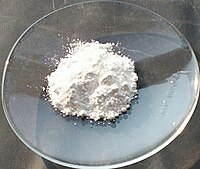
Photo from wikipedia
AbstractZinc plant residue is a secondary metal source because it has precious metals such as zinc and lead. However, since this residue contains partial ferrite structure, there is no large-scale… Click to show full abstract
AbstractZinc plant residue is a secondary metal source because it has precious metals such as zinc and lead. However, since this residue contains partial ferrite structure, there is no large-scale recovery in metallurgy industry. The aim of this study is to investigate the effect of mechanical activation of zinc plant residue in sodium hydroxide leaching. The results showed that mechanical activation obtained from high-energy mill had positive effect on the leaching of metals under condition of limited grinding time. Mechanical activation over 1 min caused the increase in particle size. It was also determined that specific surface area decreased due to onset of agglomeration of fine particles on the surface. Leaching efficiency of long-time milled residue was lower than short-time milled material’s leaching. It was determined that lead dissolution from zinc plant residue was higher than zinc dissolution in all experiments due to the presence of zinc in ferrite structure as franklinite form. Furthermore, sodium hydroxide leaching of this residue could be considered as a selective leach, since no iron was present in the solution.
Journal Title: Transactions of the Indian Institute of Metals
Year Published: 2019
Link to full text (if available)
Share on Social Media: Sign Up to like & get
recommendations!